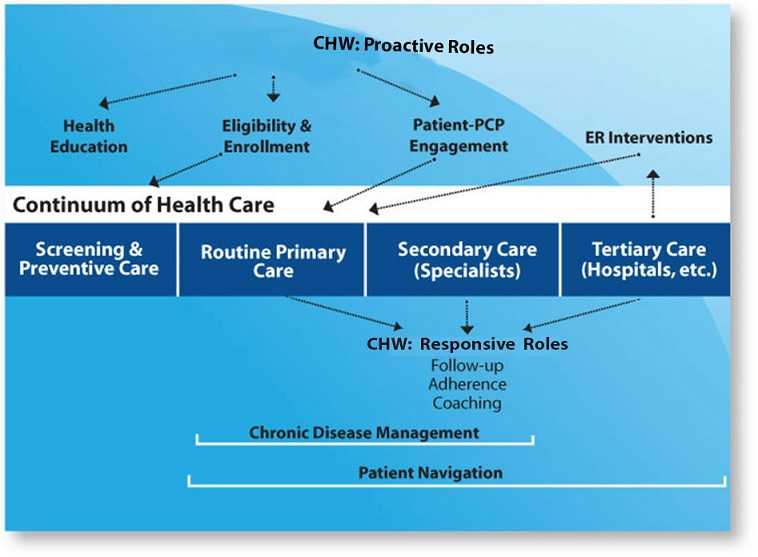CHW: Proactive Roles
| < Back | Next > |
|---|

| Proactive Roles (with arrows pointing down to Health Education, Eligibility and Enrollment, and Patient-PCP Engagement) | |||
|---|---|---|---|
|
Health Education |
Eligibility and Enrollment (with an arrow pointing down to Continuum of Health Care) |
Patient-PCP Engagement (with an arrow pointing down to Continuum of Health Care) |
ER Interventions (with an arrow pointing down to Continuum of Health Care) |
|
Continuum of Health Care |
|||
|
Screening & Preventative Care |
Routine Primary Care (with an arrow pointing down to CHW: Reactive Roles) |
Secondary Care (Specialists) (with an arrow pointing down to Reactive Roles) |
Tertiary Care (Hospitals, etc.) (with an arrow pointing up to ER Interventions and an arrow pointing down to Reactive Roles) |
|
Responsive Roles Follow-up Adherence Coaching |
|||
|
Chronic Disease Management |
|||
|
Patient Navigation |
|||
View Transcript
[SPEAKER]
The continuum of care is depicted in the bar at the center of this diagram. The upper part of the diagram presents the proactive roles of CHWs, which appear above the bar. We will talk about these roles, then turn to the responsive roles below the bar to complete a visual of the total capacity of CHWs.
Acting proactively, CHWs engage in outreach to provide direct community-based health education, to help individuals and families establish eligibility for programs and benefits, and to engage patients in screening, preventive care, and primary care.
In a role that is gaining popularity, CHWs also may help individuals who visit emergency rooms to engage more appropriate sources of care for non-emergency conditions. A number of studies have demonstrated the effectiveness of this approach. Although this role is generally proactive, sometimes individuals are referred to a CHW by an emergency department.
This lower half of the diagram shows activities for which a clinical care provider may refer a patient or family to a CHW. In these scenarios, the CHW’s role is primarily responsive and is limited to the patients or families assigned to her.
In these activities, we begin to see the CHW’s potential to improve communication between provider and patient. Studies have documented CHWs’ ability to improve patient knowledge, attitudes, and self-reported behaviors. Other studies have shown reductions in cost and improvements in clinical outcomes, both from increased patient adherence to treatment and from simple behaviors such as keeping appointments. And finally, the potential involvement of CHWs in post-discharge follow-up is important because of the recent increase in interest in care transitions and reducing hospital readmissions.
Again, we must keep in mind that the CHW is not providing clinical care, but instead is providing support, coaching, and reinforcement of information and recommendations from clinical personnel. In many cases, the CHW also provides resources and referral for non-medical services to remove barriers to participation in the health care system, enabling the individual or family to engage more actively in clinical care.
Where the individual arrows in this diagram might describe a specific program, for example, connecting patients more effectively with their primary care providers, there is potential for more broadly based programs in which the patient and CHW interact with a wider range of providers. As indicated by the bracketed notations at the bottom of this diagram, successful chronic disease management, although based in a primary care setting, often involves contact with specialists. Likewise, patient navigation may include contacts with the full range of providers and include inpatient care.
Taken together, the roles shown in this graphic describe the full range of engagement of CHWs with the health care system. Later we will discuss models in which CHWs operate entirely outside the system.
- Page last reviewed: January 26, 2016
- Page last updated: January 26, 2016
- Content source:



 ShareCompartir
ShareCompartir